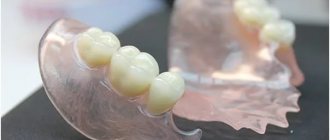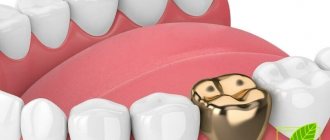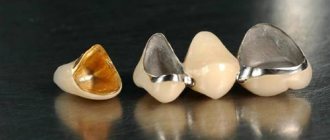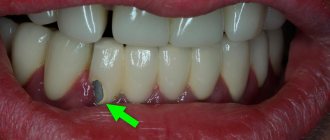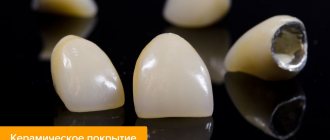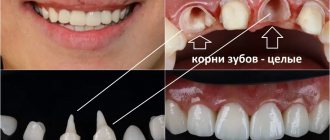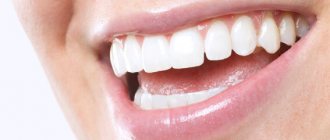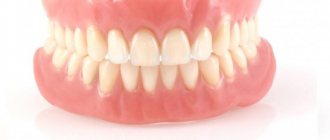Metal-ceramic crowns are the most popular method of dental prosthetics because they have a number of advantages: their appearance is as close as possible to natural, and they can last for many years without signs of wear.
Metal-ceramic prostheses are made in the form of bridges or crowns. Crowns made of this material perfectly replace molars, for which functionality is primarily important.
And although such prostheses are highly durable, they require certain care. Following some simple rules allows you to keep crowns in excellent condition and significantly increases their service life.
Crown care
Artificial teeth are not prone to decay and are not susceptible to carious damage. However, if there is no care for teeth with crowns, plaque forms on the surface and an unpleasant odor appears. These factors contribute to the formation of tartar, which, in turn, provokes serious dental problems.
Caring for ceramic crowns is simple; usually the whole procedure comes down to daily preventative cleaning of teeth and installed structures. It is not necessary to go to a dental clinic for this.
When can metal ceramics be installed?
Metal-ceramic dental crowns will be an excellent alternative to other dentures in the case of the absence of one tooth in any part of the dentition, although, given the availability today of more aesthetic dentures, metal-ceramics are preferred to be installed in the chewing area of the upper or lower jaws. Dental crowns made of metal-ceramics are often used to restore several lost teeth in a row - this design is called a “metal-ceramic bridge.” Typically, a metal-ceramic bridge replaces up to four missing teeth.
How to care for crowns
If we consider the situation as a whole, proper care of crowns is no different from the prevention of all dental diseases. However, professionals recommend following the following rules:
- Hygienic cleaning of teeth and installed structures twice a day. To do this, it is better to use pastes with a minimum abrasiveness coefficient so as not to damage the enamel and soft tissues.
- Carefully remove food debris from the interdental space. An irrigator copes with this task perfectly.
- Rinse your mouth after every meal. To do this, you can use special compounds or just warm water.
- Watch your diet. If crowns are installed, it is better to avoid eating nuts, crackers, etc.
- Control food temperature. Too hot tea or ice-cold lemonade can cause cracking of the relatively fragile cermets.
Dentists recommend massage for crown care. Such structures create increased pressure on the gums, so it is important to stimulate blood circulation in the soft tissues. The massage is performed with smooth, circular movements along and counterclockwise.
Rules of conduct after installing crowns
There are several rules that you can follow to keep your mouth healthy:
- Brush your teeth twice a day – immediately after waking up and before going to bed.
- Rinse your mouth if possible after every meal. This will get rid of food debris and slow down plaque formation.
- Thoroughly clean areas where plaque and food may accumulate. We are talking about the space under the hinged crown of the bridge. To do this, you can use an irrigator, brushes and other devices.
- You should avoid eating too hard foods and chewing on non-food items. Nail chewing, nuts, candy chewing – all of these should be avoided to maximize the life of your crowns.
- You should reduce your consumption of coffee, black tea, red wine, and other coloring foods.
- Gum care is also a very important attribute of healthy teeth. Rinsing and careful attention to the condition of soft tissues are required.
- Cleaning your tongue is a very useful activity. Plaque also accumulates here and must be removed.
Careful care will help maintain health and maximize the service life of any restorations.
Seeing a doctor
You need to make an appointment with a dentist if the following problems occur:
- The installed structure has lost stability;
- There is an unpleasant odor from the mouth;
- An inflammatory process is observed on the gums, pain is felt;
- The crown is installed incorrectly, causes discomfort to the person, and interferes with other teeth;
- The prosthesis fell out.
In addition, you need to visit the clinic for professional preventive cleaning and crown replacement. The service life of such structures varies between 2-15 years, depending on the material of manufacture and compliance with operating rules. Even if the service life of the crown has not expired, it is better to replace it if the color changes or cracks appear. Do not self-medicate, it is better to consult a specialist!
Do I need to take care of artificial teeth?
Of course, these are not real teeth and caries cannot develop on them. But do not forget that crowns are either attached to natural teeth or are firmly adjacent to them. That is, the restored tooth is a full-fledged participant in the dentition and the entire dentofacial apparatus and affects all its elements. Plaque can form on the surface of the crowns, causing not only an unpleasant odor, but also gum disease. Hygiene flaws inevitably lead to a number of problems:
- Secondary caries under the crown.
- Inflammatory processes of soft tissues, the appearance of gum pockets.
- Damage to adjacent teeth due to plaque accumulation.
- Deterioration of the body's condition due to constant exposure to bacteria accumulated on the teeth.
The benefits of an irrigator when caring for zirconium crowns
The irrigator is ideal for caring for zirconium crowns and dental structures. The operating principle of the irrigator is based on a directed pulse of water with adjustable intensity. Such equipment massages the gums and effectively cleans the interdental space. Unlike dental floss, it is impossible to damage soft tissues with an irrigator; there is absolutely no discomfort during such treatment.
You can purchase the irrigator in a stationary or portable version. The second option is slightly inferior in terms of water capacity, but you can take the device with you and care for your oral cavity while traveling.
Author of the article
Metal-ceramic dentures
Metal-ceramic dentures are dental crowns consisting of a metal frame and a ceramic coating. This design looks quite natural and lasts a long time, so metal-ceramic crowns are installed both in place of one missing tooth and several teeth in the dentition (in this case we are talking about a bridge made of metal-ceramics). The metal-ceramic frame of the future crown is made from alloys of nickel and chromium, cobalt and chromium, a base of palladium and silver, gold or platinum. The latter components rarely fit into the pricing policy for metal-ceramic crowns, which stably maintains the demand for this type of dental crown, so the decision to install a metal-ceramic crown is still supported taking into account inexpensive manufacturing materials, which ensure the low cost of metal-ceramic dentures.
Toothbrush and how to use it correctly
You can choose any toothbrush for fixed bridges. But only of medium hardness, otherwise the bristles simply won’t cope with plaque. However, there are exceptions, for example, the ultra-soft brush from Curaprox (“Curaprox”) - its bristles are located very tightly to each other and do a good job of cleansing.
The brush should be changed every 3-4 months. You also need to purchase a new brush immediately after dentures or after undergoing professional oral hygiene at the dentist. Because germs have accumulated on something that has already been used (even for a couple of weeks).
It is necessary to clean dental bridges in the morning (before or after breakfast) and in the evening before going to bed - that is, the usual hygiene for 2 minutes, 2 times a day. You need to use a brush according to the same principle as with natural teeth. First, moisten the tool with water, apply a pea of paste and position the brush head at an angle of 45 degrees to the teeth. Cleaning vertical surfaces is carried out with sweeping movements from the gums to the cutting edge. On the upper jaw we “sweep out” plaque and food debris, moving from top to bottom, and on the lower jaw, on the contrary, from bottom to top. When all surfaces from the cheeks, lips, tongue and palate are cleaned, then we move on to the horizontal planes (chewing surfaces) - they are cleaned with back and forth movements.
After brushing, rinse your mouth with clean water or mouthwash. Also, after brushing with a regular brush, you can use a mono-beam brush (without paste) to clean the interdental spaces. But a double-sided brush for removable dentures will not work here - it will be inconvenient to use.
Is home hygiene sufficient for care?
No matter how good oral hygiene is at home, it alone is not enough to care for fixed and removable dentures. After all, it is impossible to completely remove plaque on your own, so orthopedic structures become duller over time and acquire a yellow tint. Therefore, it is recommended to visit dentistry once every 6-12 months for professional1 oral hygiene. Which doctor should I see at the clinic? First, you need to visit an orthopedic dentist for an examination, and for cleaning, contact a dental therapist or hygienist.
1Nikolaev A.I., Tsepov L.M., Makeeva I.M., Vedyaeva A.P. Professional and individual oral hygiene in adults, 2018.
QUESTION ANSWER
QUESTION Tell me, is it possible to clean a dental bridge with an ultrasonic brush? Anna P.
ANSWER Hello, Anna. No, because ultrasonic waves can damage the cement that glues the bridge to the abutment tooth. Then the prosthesis may fall off, and you will have to go to the clinic and put it in place. It is better to give preference to a regular hand tool - the main thing is that the brush is of high quality, with a large number of bristles.
Author: Dulgarov Zh. G. (Thank you for your help in writing the article and the information provided)
How do you know when it’s time to change crowns?
Cracks, poor fixation on the tooth, discoloration, discomfort when closing the jaws - all these are reasons to consult a doctor. A crown can fail either after 2-3 years or after 10-15 years - a lot depends on the initial situation, the professionalism of the doctor, the quality of the material, as well as on how the teeth were used. We strongly recommend visiting the dentist 1-2 times a year to examine the oral cavity - the doctor will be able to assess the quality of fixation of the prosthesis and its integrity. This way, you won’t have to guess how long the crowns will last, but will be able to understand exactly when you need to worry about replacing them.
All recommendations boil down to the fact that crowns, inlays and bridges, like living teeth, require regular care and careful treatment. Do not forget that in addition to artificial crowns, living tissues remain in the oral cavity - these are gums and ligaments that hold the root of the tooth. All of them are susceptible to inflammatory processes, which can lead to the loss of the remaining living tooth along with the installed prosthesis.
What's wrong with dental bridges?
Despite the obvious advantages, bridges have very serious disadvantages. Among them is the need for depulpation and grinding of supporting teeth, even if they are completely healthy. In addition, bridges do not eliminate such an unpleasant consequence of tooth loss as bone loss. Those with bridges will have to pay special attention to the care of their dentures. But the most serious disadvantage of this type of prosthetics is the excessive load on the supporting teeth, as a result of which they deteriorate and become loose. As a rule, in the future this leads to their complete loss.
Make an appointment
right now!
Voronkov Sergey Sergeevich
Therapist, Orthopedist, Hygienist


